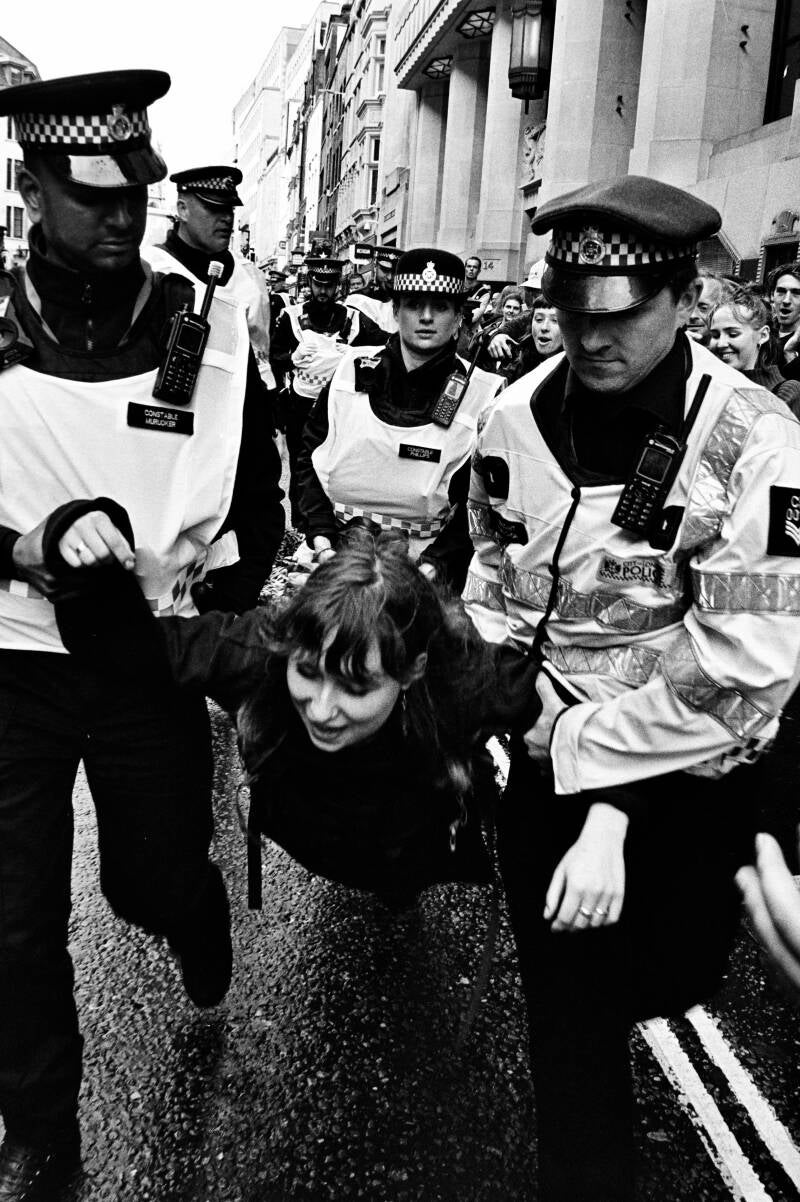David Gilbert Wright.
Documentary Photographer.
Modern Protest in England.
There has been a very long tradition of protesting in a variety of ways in the British Isles. The Chartists in the early 19th Century advocated the use of violence as they did not believe their demands would be met by peaceful methods. The Suffragettes were activists trying to get the vote extended to women the early 20th Century. They used a variety of militant methods to grab publicity. These methods included the use of art, trespass, arson, marches, riots and chaining themselves to buildings. Emily Davison walked onto the racetrack of the Derby and was killed by oncoming horses. Sit-ins became a means of attracting attention.
Strikes and refusing to work have been prolific as a means of gaining better pay and working conditions for much of the 20th Century. The advent of trade unions gave workers strength. Their actions usually involved withdrawing their labour together with lock-ins, marches and demonstrations. In May 1968, student sit-ins began at the London School of Economics and Hornsey College of Art. The latter lasted six weeks and was a protest about the state of Art Education in England.
Bobby Sands was a political prisoner in the Maze in Northern Ireland from 1976 until his death in May 1981. After a number of attacks on prisoners in their cells he like others, refused to wear prison uniforms, dressing in blankets instead. They refused to leave their cells to empty chamber pots, and smeared faeces on the walls. In 1980 he was chosen as the leader of the group of Irish Republican prisoners who protested about the removal of Special Category Status that had previously freed them from ordinary prison regulations. In 1981, Sands went on hunger strike, protesting that they should be considered as political prisoners not criminals. The strike attracted international attention. Bobby eventually died while on hunger strike on 5th May 1981.
The Women’s Peace Camp at Greenham Common was established to protest against nuclear missiles being allowed to be stored there. The women camped around the base and sung songs chained themselves to the fence and formed a 14-mile human chain around the entire perimeter. They dressed as witches to fool the police that they were participating in a Halloween event and then took down a nine-mile length of the perimeter fence.
Groups have been protesting about environmental issues for decades. The term was coined in the 1960s and their actions were often directed at the building of motorways, railways and removal of trees. Activists would sit in front of bulldozers and climb up trees and sit it out.
The first climate-change protests began in January 2017 when Roger Hallam, one of the Extinction Rebellion founders sprayed water-soluble chalk-based spray paint on the London Campus of Kings College to persuade them to stop using fossil fuels. In November 2018, Extinction Rebellion blocked bridges in London. Then in 2019, the climate-change campaign across the country began in earnest.
Their approach to protest has combined many of the strategies described above. They march, they sing and play instruments such as drums, they hold strikes, trespass, use art and caused obstructions. They also adopt more non-violent passive resistance as a means to draw attention globally. They do this by using their bodies as a means of obstruction. They lie down on roads and in public buildings (collectively called a’ Die-in’); live in trees; chain themselves to railings and glue themselves to roads, trains, doors and each other. Their aim is to cause mass arrests for obstruction and criminal damage so they can draw attention to what they describe as the much greater criminal damage mankind is doing to the environment.
Climate-Change Activists are also different from other ‘tribes’ because they are connected globally to ‘tribes’ in other countries who are pursuing the same agenda for change. They communicate using social media, which enables rapid dissemination of information and provides support for orchestrated action. The significant demographic of this ‘tribe’ is one of gender. It appears that the majority of Climate-Change Activists out on the streets are white, ‘middle-class’ women and teenage girls aged between 14 and 35 years old.
It is interesting to note that the protests become increasingly more visual. Costumes, oversized props, gardens on London bridges, actors on stilts and classically trained orchestras are featuring in their actions. They spray buildings red, interrupt public events by throwing orange confetti and attempt to fly drones near airports.
I spent 2019 documenting the demonstrations and events in London. My reason was that I had been working on a much bigger project entitled ‘The Modern Tribes of England’. I believed the Climate-Change Activists are a new and emerging ‘tribe’. Their activities give them their identity and forms the ‘glue’ within the group. The ‘tribe’ is very similar to other modern English ‘tribes’ because its members are drawn from all walks of life. It is also a group that seeks to contribute to society something it believes to be a good, just as Morris dancers contribute culturally and Urban Agriculturalists endeavour to make towns and cities greener. However, Climate-Change Activists differ in that through their actions, they hope to change behaviour, policy and ultimately, economics. The full series can be viewed on my website and is divided into four broad sets in order to understand this group, their actions and beliefs better. These are: People, Protest, Non-violent passive resistance and Arrest.
Website: www.davidwright.photography/Portfolios
Instagram: @davidgilbertwright
Facebook: @davidgilbertwright
Twitter: @DavidGilbertWr1
